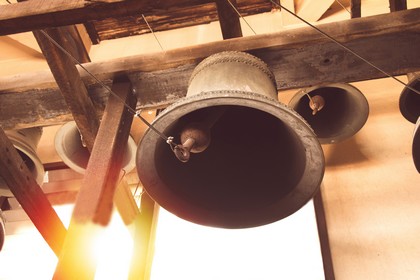At Easter we will hear the sound of the bells rebounding from one church to another announcing life over death. Every Sunday the ringing of bells call us to celebrate our Lord’s day. Sometime ago I got to know Fr. Davide Zanoni, a country priest! Thanks to him I have discovered a world that I had underestimated. He gave me a lot of information. For example, I now know that the largest bell in Austria is kept in St. Stephen’s Cathedral in Vienna, which was cast for the first time in 1711 as a thank you for having escaped the Turkish invasion, in the battle that took place in 1683. For the occasion, a bell weighing 18 tons was made with the cannons captured from the Turkish army.
It required many men to be rung and for this reason it was rarely used. Unfortunately, due to a fire in 1945, this bell fell and shattered; but in 1951 it was reassembled using the material from the broken one and adding the bronze from the cannons, taken from the historical museum, which also belonged to the Turkish army. This new bell was made thanks to the contribution of all the federal states of Austria, weighs 20 tons and is rung on the solemnities of the liturgical year, but also on Ash Wednesday, marking the beginning of a new Lenten journey with its tolling. During World War I, the Austrian and German empires, finding themselves short of material to make cannons, chose to requisition church bells, and that is why areas such as Trentino Alto Adige, much of Austria and Germany saw their bell towers deprived of many bells: this also happened to the cathedral of Trent.
That is why in 1918, at the end of the war, there were questions about how to restore the lost bells that had been demolished and turned into cannons. The city of Mantua organized a great fundraiser to return six new bells to the cathedral of Trent, cast in 1920 probably with cannons too: so, those bells, transformed into instruments of death, once again became instruments announcing the resurrection, the celebrations and the happy and sad events of life. But the news that struck me the most was about a foundry in Innsbruck, one of the largest and most prestigious in Europe, operating since 1599. Here, by tradition, bell casting takes place strictly on Fridays at 3 p.m., precisely in close connection with the Lord’s death.
The owners say that just as Jesus Christ died and descended into the underworld of the earth and then rose again, the liquid metal, the bronze that is shiny, descends into the dark and gloomy cavity of the mould and rises again as a bell. It is a very heartfelt tradition and lived with faith. When the casting takes place, the parish for which the bell is destined and the priest are invited to invoke the Lord’s blessing on the molten metal; then the owner asks those present to say the Lord’s Prayer in their own language. In the instant before pouring the metal he usually declares, “In the name of God”. Then in strict silence the pouring takes place. It is a very delicate step, because if done incorrectly, it can compromise months of work.
The world of the bells is really rich in symbols, historic references and messages. Isaiah’ words resound: “They will forge their swords into ploughshares” (Isaiah 2:4). We could say: they will cast their cannons and make bells of them to announce the cry for peace.
Elide Siviero


 Italiano
Italiano Français
Français
